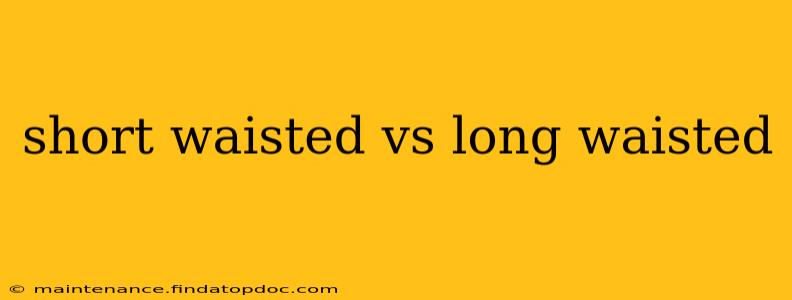Knowing your body type can significantly impact your style choices, helping you choose clothes that flatter your figure and enhance your natural proportions. One key aspect of body shape is the length of your waist. Understanding the difference between a short waist and a long waist can revolutionize your wardrobe and boost your confidence. This comprehensive guide will delve into the nuances of short versus long waists, helping you identify your body type and dress accordingly.
What is a Short Waist?
A short waist is characterized by the distance between your ribs and your hips being relatively shorter than the average. This means the torso appears compact, with less space between the ribcage and the pelvic bone. This isn't necessarily about overall height; a short-waisted person can be tall or short. The defining factor is the proportion of the torso relative to the legs. Individuals with short waists often appear to have longer legs in comparison to their torso length.
What is a Long Waist?
Conversely, a long waist is defined by a longer distance between the ribs and the hips. This creates a more elongated torso, visually shortening the legs in proportion. Again, overall height isn't the primary determinant; a long-waisted person can be tall or short. The key is the proportional relationship between the torso and the legs.
How to Determine Your Waist Length
The easiest way to determine whether you have a short or long waist is to visually assess your body proportions. Look in a full-length mirror and observe the space between your rib cage and your hips. If this space seems relatively short, you likely have a short waist. If it appears longer, you probably have a long waist.
You can also try a simple measurement:
- Measure your torso: Measure from the base of your neck (where it meets your shoulder) to your hip bone (the top of your hip).
- Measure your legs: Measure from your hip bone to the floor.
- Compare: Compare the measurements. A significantly longer torso measurement indicates a long waist, while a shorter torso measurement suggests a short waist.
What are the Advantages and Disadvantages of Each Waist Type?
Both short and long waists are beautiful and each has its own set of advantages and disadvantages when it comes to clothing choices.
Short Waist:
- Advantages: Often creates the illusion of longer legs, a universally flattering feature.
- Disadvantages: Can sometimes make the torso appear shorter or stockier if not dressed appropriately. High-waisted clothing can sometimes feel less comfortable.
Long Waist:
- Advantages: Can create a balanced and harmonious figure when dressed correctly.
- Disadvantages: Can make the legs appear shorter, requiring strategic styling to elongate the lower body.
How to Dress for a Short Waist
The goal with a short waist is to create the illusion of a longer torso, often by visually elongating the legs. Here's how:
- High-waisted bottoms: Avoid these, as they will further shorten the torso.
- Empire waistlines: These dresses and tops emphasize the upper part of the body, creating balance.
- Vertical lines: Vertical stripes or seams create a lengthening effect.
- Belts at the natural waist (carefully): Used strategically, a belt can highlight the waist without making it appear shorter.
- Longer tops: Avoid cropped tops; opt for tops that hit at or below the hip.
How to Dress for a Long Waist
The goal with a long waist is to visually elongate the legs and create balance between the torso and lower body. Here's how:
- High-waisted bottoms: These are your friend! They visually lengthen the legs.
- A-line skirts and dresses: These styles create a flattering silhouette.
- Cropped tops: These can create a balanced look by drawing attention to the upper body.
- Vertical lines: These again create a lengthening effect.
- Belts at the natural waist: These can define the waist and create better proportions. Consider placing them higher than usual.
Can You Change Your Waist Length?
Your natural waist length is largely determined by genetics. However, you can influence how your waist appears through exercise and posture. Core strengthening exercises can improve your posture, potentially making your waist appear slightly shorter or more defined. Remember, clothing choices are the most impactful way to adjust your visual proportions.
Frequently Asked Questions
What body type is associated with a short waist?
There isn't one specific body type solely associated with a short waist. Individuals of all body types (e.g., hourglass, rectangle, pear) can have either short or long waists.
What body type is associated with a long waist?
Similarly, a long waist isn't exclusive to any particular body type. Anyone can have a long or short waist regardless of their overall body shape.
Can I change my body type?
You can’t drastically change your bone structure, but you can alter your body composition through diet and exercise, potentially affecting how certain clothes fit.
Are there any exercises to make my waist appear shorter or longer?
While you can't actually change your bone structure, core-strengthening exercises can help improve posture and create a more defined waistline, potentially affecting its visual appearance.
By understanding your waist length and following these styling tips, you can confidently choose outfits that highlight your unique figure and enhance your overall appearance. Remember, it's all about emphasizing your best features and creating a balanced silhouette.
